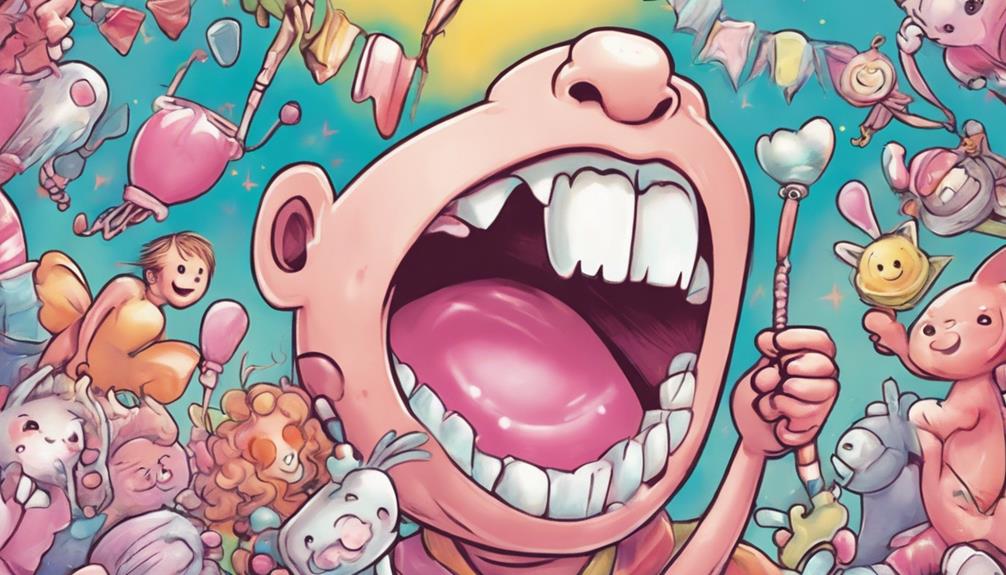The first teeth to come in for babies are usually the lower central incisors, which tend to appear between 6 to 10 months old. Following these, the upper central incisors emerge around 8 to 12 months. It's important to know that every baby is different, so teething schedules can vary. You might notice some signs of teething, like drooling or fussiness, around this time. Managing discomfort is key as these early teeth pave the way for your baby's future oral health. If you go on, you'll discover more valuable insights about the teething process and what to expect! The next phase of baby teeth eruption includes the emergence of the lateral incisors, which typically comes in around 9 to 13 months. It’s common for babies to experience some discomfort during this time, so providing gentle massage or teething toys can help alleviate their teething pain. Understanding the progression of baby teeth eruption can help you better support your baby through this crucial developmental milestone.
Key Takeaways
- The first teeth to appear in babies are the lower central incisors, typically erupting between 6 to 10 months of age.
- Upper central incisors follow next, usually emerging between 8 to 12 months.
- Lateral incisors come next: upper ones appear between 9 to 13 months, and lower ones between 10 to 12 months.
- First molars erupt around 13 to 19 months, followed by canines and second molars by age three.
Understanding Teething

Teething can be an uncomfortable rite of passage for your baby, usually starting between 6 to 12 months of age. As babies start teething, you may notice the first tooth erupts, typically the lower central incisors. This process can be challenging for both you and your little one, as it often comes with various signs of teething. You might see increased drooling, fussiness, or a desire to chew on objects as your baby's gums become sore.
Understanding this phase is vital because these primary teeth play an important role in your child's development. They help with chewing, speaking, and maintaining the correct spacing for future permanent teeth. While the lower central incisors usually come first, the sequence of eruption will continue with the upper central incisors and other teeth. Each baby experiences teething differently, so it's important to be patient and supportive during this time.
Recognizing the signs of teething can help you provide comfort and relief, making this change smoother for both of you. Being prepared for this natural milestone will help you navigate the challenges of teething with ease.
Timeline of Tooth Eruption

The timeline for tooth eruption in babies typically begins around 6 months, starting with the lower central incisors. These are usually the first teeth to come in, appearing between 6 to 10 months of age.
After the lower central incisors, you'll often see the upper central incisors emerge, typically between 8 to 12 months.
Next up are the lateral incisors. The bottom lateral incisors usually come in around 10 to 12 months, while the top ones follow a bit earlier, appearing between 9 to 13 months.
As your baby approaches the 13 to 19 month mark, the first molars generally erupt, bringing in larger teeth to the mix.
Canines will then appear, typically between 16 to 22 months, adding to your child's growing smile.
Finally, the second molars complete the set, with the bottom ones coming in between 25 to 33 months and the top ones around the same timeframe.
To keep track of all these developments, refer to a tooth eruption chart, which can help you monitor your baby's dental growth effectively.
First Teeth to Appear

When your baby starts teething, you'll likely notice the first teeth to appear are the lower central incisors, typically between 6 to 10 months.
Following those, the upper central incisors usually come in around 8 to 12 months.
Understanding this timeline can help you recognize the order of eruption and any teething symptoms your little one might experience.
Timeline of Eruption
Curious about how your baby's teeth will emerge? The journey usually starts with the lower central incisors, which typically appear between 6 to 10 months. After that, you'll generally see the upper central incisors coming in around 8 to 12 months.
Next up are the lateral incisors, with the upper lateral incisors usually erupting between 9 to 13 months, while the lower lateral incisors follow closely between 10 to 12 months.
As your baby grows, expect the first molars to emerge next, typically between 13 to 19 months. After the first molars, the canines, also known as cuspids, usually come in around 16 to 22 months.
Finally, the second molars round out the teething process, with the lower second molars appearing between 25 to 33 months and the upper second molars not far behind.
This timeline can vary for each child, but knowing what to expect can help you prepare for those exciting, and sometimes challenging, teething moments. Keep an eye on your baby's mouth, and you'll soon see that adorable smile filled with new teeth!
Order of Teeth
Understanding the order in which your baby's teeth appear can help you anticipate their teething journey more effectively.
Typically, the first teeth to emerge are the lower central incisors, usually making their debut between 6 to 10 months. After that, you can expect the upper central incisors to come in around 8 to 12 months.
Next, the lower lateral incisors usually appear between 10 to 14 months, followed by the upper lateral incisors, which typically come in between 9 to 13 months after the central incisors.
As your baby continues to grow, the first molars will erupt between 13 to 19 months, making way for the canines, which generally appear between 16 to 22 months. Finally, the second molars will show up last, usually between 25 to 33 months.
Being aware of this order can help you manage your expectations and understand what to look for as your baby navigates the teething process.
Every baby is different, but knowing this timeline can give you a clearer picture of their dental development.
Teething Symptoms Noted
Teething often brings a variety of symptoms as your baby's first teeth start to appear. Typically, the first teeth to emerge are the lower central incisors, which usually erupt between 6 to 10 months.
As this process unfolds, you may notice several teething symptoms in your baby. Common signs include increased drooling, irritability, and a desire to chew on objects. Your little one might also experience teething pain, which can lead to disrupted sleep or a decreased appetite.
While each baby is unique, these symptoms often coincide with the arrival of the primary teeth. After the lower central incisors, the upper central incisors usually come in around 8 to 12 months.
You might notice that your baby's gums appear swollen or red where the teeth are pushing through, and they may be more fussy than usual. If you suspect your baby is in discomfort, gentle gum massages or teething toys can provide relief.
Teething Symptoms to Watch

When your baby starts teething, you'll notice some common symptoms that can be concerning.
It's important to understand how long these symptoms may last and when it's time to consult your pediatrician.
Let's explore the signs you should watch for during this challenging phase.
Common Teething Symptoms
Many parents notice several common symptoms in their babies as they begin to teethe. One of the most noticeable teething symptoms is frequent drooling. You might find yourself wiping your baby's face often to prevent rashes caused by excess saliva.
Alongside drooling, irritability often ramps up during this time; your little one may be fussier than usual as they struggle with teething discomfort. You may also observe swollen gums, a clear sign that teeth are on the way. When you check your baby's mouth, those tender gums might look red and inflamed.
Some babies even experience disrupted sleep patterns due to the discomfort, making nighttime more challenging for both of you. In addition to these symptoms, babies often resort to chewing on objects or their fingers to relieve the pressure in their gums.
While a slight temperature rise below 102°F can be normal during teething, keep an eye out for high fevers or diarrhea, which might indicate an illness unrelated to teething. Recognizing these symptoms will help you support your baby through this developmental milestone.
Duration of Symptoms
Symptoms related to the eruption of your baby's teeth can start around 3 months and may persist until all primary teeth emerge by age 3. Teething symptoms often include increased drooling, irritability, and swollen gums.
The first teeth to appear are usually the bottom front teeth, known as the lower central incisors, which typically erupt between 6-10 months. As your baby experiences teeth eruption, you might notice that each tooth can cause discomfort for several days.
The duration of symptoms varies, lasting anywhere from a few days to a week for each tooth. You may see your baby's gums becoming red and swollen in the days leading up to the eruption, signaling that the first teeth are on their way.
While some fussiness and disrupted sleep patterns are common during this time, keep an eye on your baby's overall health. If you notice symptoms like a high fever or diarrhea, it's important to consult a healthcare provider, as these could indicate other issues unrelated to teething.
Understanding the duration of teething symptoms can help you support your baby through this natural developmental phase.
When to Consult Pediatrician
It's important to know when to consult a pediatrician during your baby's teething journey, especially if you notice any concerning symptoms.
Keep an eye out for a high fever above 100.4°F (38°C); this could indicate an illness unrelated to teething. If your baby has persistent diarrhea or vomiting, it's vital to seek medical advice, as these symptoms aren't typical for teething.
Watch for any unusual rashes or skin irritations that appear alongside teething symptoms. These could signal an allergy or other medical issue requiring attention. If your little one seems excessively irritable or inconsolable, and typical teething remedies aren't bringing relief, don't hesitate to consult your pediatrician for further assessment.
Always reach out to a healthcare provider if you're concerned about your baby's teething symptoms or overall health, particularly if they deviate from the expected timeline.
Your pediatrician is there to help you navigate any challenges during this developmental stage, ensuring your baby stays healthy and comfortable. Trust your instincts—if something feels off, it's best to get professional advice.
Managing Teething Discomfort

When your baby starts teething, managing their discomfort can make a significant difference in their mood and sleep. To soothe those sore gums, try gently rubbing your baby's gums with a clean finger. You can also offer chilled teething rings or cold washcloths for relief. The coolness helps numb the gums, easing their pain.
Solid rubber teethers are a safe option for chewing, so be sure to avoid plastic or liquid-filled teething rings, as they can pose safety risks. If your baby seems particularly uncomfortable and inconsolable, it might be time to consult your healthcare provider. They can recommend appropriate pain relief options, such as acetaminophen or ibuprofen, if necessary.
However, be cautious with teething gels. Avoid any products containing benzocaine, as they're not recommended for infants due to potential safety concerns.
Importance of Dental Hygiene

You know that starting dental hygiene early can make a big difference for your baby's oral health.
By establishing healthy habits now, you're setting the foundation for a lifetime of strong teeth and gums.
Let's explore how these practices benefit your child and promote good dental health.
Early Care Benefits
Establishing a dental care routine early not only prevents cavities but also sets the foundation for a lifetime of healthy oral habits. As soon as your baby's first tooth emerges, start wiping their gums to promote good oral hygiene. This practice helps in preventing cavities and guarantees that their teeth are healthy. Teething can be uncomfortable, but maintaining a consistent brushing routine can ease some of that discomfort and set your child up for success.
Once your child reaches age 2, you can introduce fluoride toothpaste, as recommended by your pediatrician. This strengthens the tooth enamel and reduces the risk of decay. Regular dental check-ups should begin by age 1, allowing for early detection of any dental issues and providing guidance on proper oral hygiene practices.
When your child is between 3 and 6 years old, teach them to brush and floss their teeth with your supervision. This is essential for establishing habits that can last a lifetime. By maintaining good oral hygiene from infancy, you're supporting not just their dental health but also their speech development and nutrition, guaranteeing that their primary teeth are healthy for chewing and helping with the alignment of future permanent teeth.
Establishing Healthy Habits
Starting a dental hygiene routine early lays the groundwork for your child's lifelong oral health. As soon as your baby's first tooth erupts—typically around six months—it's time to establish a consistent brushing habit. Before teeth appear, clean your baby's gums with a soft cloth to remove bacteria. Once the first tooth is visible, brush with a tiny smear of fluoride toothpaste.
Aim to brush your child's teeth twice daily, ideally after breakfast and before bedtime. This not only helps in developing good habits but also promotes healthy gums and teeth. Regular dental check-ups should be scheduled by age one or when the first tooth appears. These visits are essential for monitoring dental health and ensuring your child's teeth are developing properly.
Between ages three to six, teach your child proper brushing and flossing techniques, always supervising until they can manage independently. Instilling these habits early encourages a positive attitude towards dental care, setting them up for a lifetime of healthy smiles.
Safe Teething Remedies

Safe teething remedies, like chilled teething rings and cold washcloths, can effectively soothe sore gums while guaranteeing your baby's safety. As your little one goes through teething, you'll want to explore various options that bring comfort without the risks associated with certain products.
Here's a quick reference for safe teething remedies:
| Remedy | How It Soothes | Safety Precautions |
|---|---|---|
| Chilled Teething Rings | Provides cold relief | Use solid rubber, avoid liquid-filled options |
| Clean Washcloths | Soft texture to chew on | Confirm they're cold and clean |
| Teething Biscuits | Chewy distraction | Monitor for choking hazards |
| Chamomile Tea | Natural calming effect | Consult pediatrician first |
Common Teething Myths

Many parents hold onto common myths about teething that can lead to unnecessary worry and confusion. Understanding the facts can help you navigate this challenging time more effectively. Here are three common myths to reflect upon:
- Teething causes diarrhea: This is a common myth with no scientific backing. Diarrhea usually indicates other health issues, not teething.
- Teething always results in high fevers: While some babies may experience a mild temperature rise, it's typically below 100.4°F (38°C). Significant fevers aren't a direct result of teething.
- Teething gels are safe: Many parents mistakenly believe that teething gels, especially those containing benzocaine, are safe for infants. The FDA warns against these products due to potential serious side effects.
Additionally, while excessive drooling is often associated with teething symptoms, it's essential to recognize that this natural response can occur independently of teething.
When to See a Dentist

By the time your baby turns one or gets their first tooth, it's essential to schedule a dental visit to guarantee proper oral health and development. This first dental visit should occur within six months after the first tooth erupts.
Pediatric dentists can assess your baby's teething progress and provide important guidance on effective oral hygiene practices tailored for infants. Regular check-ups help establish a dental home, making it easier to monitor your child's dental health as their primary teeth emerge.
These visits play a significant role in preventing potential issues like cavities and alignment problems down the line. It's also important to consult a dentist if you notice unusual symptoms during teething, such as a persistent high fever, severe irritability, or prolonged drooling that goes beyond typical teething symptoms.
Early dental visits familiarize your child with the dental environment, reducing anxiety for future appointments. Prioritizing these visits sets a solid foundation for your child's oral health, ensuring they're on the right path to a healthy smile as they grow.
Tips for Parents During Teething

As your baby goes through the teething process, there are several effective strategies you can use to ease their discomfort and support their development.
Here are three tips to help soothe your little one during this challenging time:
- Use a Clean Finger: Gently rub your baby's gums with a clean finger. This can provide immediate relief and comfort for their teething discomfort.
- Chilled Teething Rings: Offer your baby chilled teething rings or frozen washcloths to gnaw on. The coolness can help numb their gums, making teething more bearable. Just avoid rings with liquid inside, as they can pose safety risks.
- Keep the Face Dry: With increased drooling during teething, it's important to keep your baby's face dry to prevent rashes. A clean, soft cloth can help wipe away excess drool.
If your baby seems to be in significant pain or you're unsure about using any pain relief medication, consulting a pediatrician is vital. They can guide you on safe options and guarantee your baby's well-being during this phase.
Frequently Asked Questions
Can Baby Teeth Come in Out of Order?
Yes, baby teeth can come in out of order. It's normal for infants to experience variations in the sequence of tooth eruption. Just keep an eye on your child's development and consult a dentist if concerned.
In What Order Do Babies Teeth Come Through?
Did you know that about 85% of babies get their first tooth by 12 months? Typically, they'll follow a pattern: lower central incisors first, then upper ones, followed by lateral incisors, molars, and canines.
Which Teeth Are Most Painful for Babies?
When your baby's teeth start coming in, you might notice that the molars cause the most pain. Their larger size puts extra pressure on the gums, leading to irritability and disrupted sleep for your little one.
What Teeth Do Newborns Get First?
When you're wondering about newborns' first teeth, you'll find that lower central incisors usually emerge first, typically between 6 to 10 months. This process can be exciting, yet it might also bring some discomfort.
Conclusion
To sum up, understanding your baby's teething journey can make a big difference for both of you.
Did you know that most babies will have their first tooth by around six months old? Staying informed about what to expect helps you manage their discomfort and provides reassurance.
Remember, every child is unique, so don't hesitate to reach out to your pediatric dentist if you have concerns.
You're not alone in this exciting phase of parenthood!









